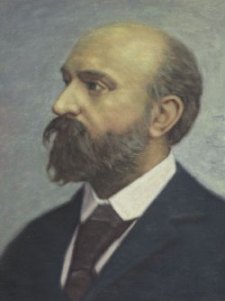Ernest Chausson - Concert for violin, piano & string quartet in D major, Op.21
Ernest Chausson - Concert for violin, piano & string quartet in D major, Op.21

1. Decide, Calme, Anime 2. Sicilienne 3. Grave 4. Tres anime Jascha Heifetz – violin Jesus Maria Sanroma – piano Musical Art Quartet
This rich, warm-sounding, melodic example of late French Romanticism practically defies categorization. Although Chausson called it a concerto (concert, in French), this composition for six players is certainly not that. "Sextet" would be wrong, because that name implies some equality among the players, missing here. The best description would be "duet (or concerto) for violin and piano with string quartet accompaniment." Chausson called the two main instruments "projections against the quartet background." For long stretches of the piece, virtually all the musical interest is in these two instruments; the other strings only occasionally respond.
Stytlistically it is clear that Chausson seeks to avoid the spell that Richard Wagner (1813-1883) cast over late nineteenth century French music. He still uses the rich chromatic harmonies and the passionate melodic style that had come into French music in the 1870s and 1880s. But his textures and use of chords suggest an effort to find a non-Wagnerian sound through a deliberate archaism. One device he uses is parallel octaves in the part writing, which suggests old church chant. Another is the consistent use of the plagal cadence (the "church" or "amen" ending) instead of the ordinary type. These almost subconscious religious associations give the music the desired antique quality. In addition, Chausson frequently uses special effects such as arpeggios, trills, and tremolos.
The first movement is based on a three-note motive introduced at the start by the piano. A main theme grows from it. A speedup in tempo leads to one of the several unaccompanied duets for violin and piano in the work. Instead of classical-style development, Chausson offers a further flow of rich melody.
The second movement is in the old Baroque Sicilienne dance rhythm, with a light, restrained, and graceful mood. The violin has two fine themes. The third movement is a somber piece in slow tempo, featuring another section for the two main instruments without the quartet. This one is brooding and distracted in mood. The finale is in the bouncing triple-time gigue rhythm, but has the driving character of a toccata. Despite the rhythmic emphasis, Chausson introduces yet another rich and expressive melody, this time given to piano, as a contrast to the predominantly forward-moving melody.
Chausson dedicated the work to the famous Belgian violin virtuoso Eugène Ysaÿe, evidently in hopes that this would prompt him to play it. In fact, Ysaÿe did play the first performance, in Brussels in 1892, as the soloist, with pianist Auguste Pierret and members of the Ysaÿe Quartet. Upon finishing his creation, Chausson remarked: "Another failure!" Posterity vigorously disagrees. ---Joseph Stevenson, Rovi
download: uploaded anonfiles mega 4shared mixturecloud yandex mediafire solidfiles
Zmieniony (Wtorek, 01 Październik 2013 11:17)








